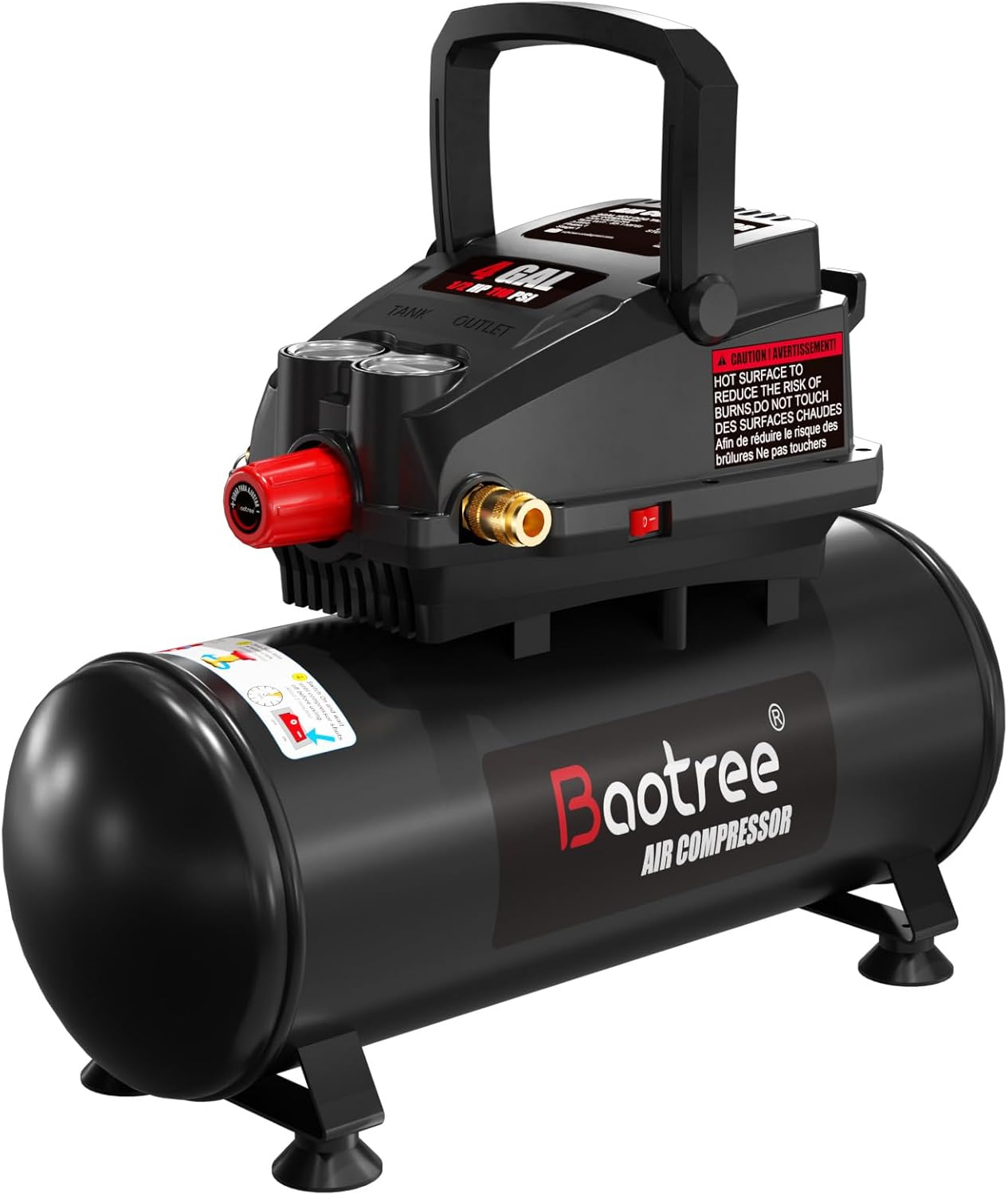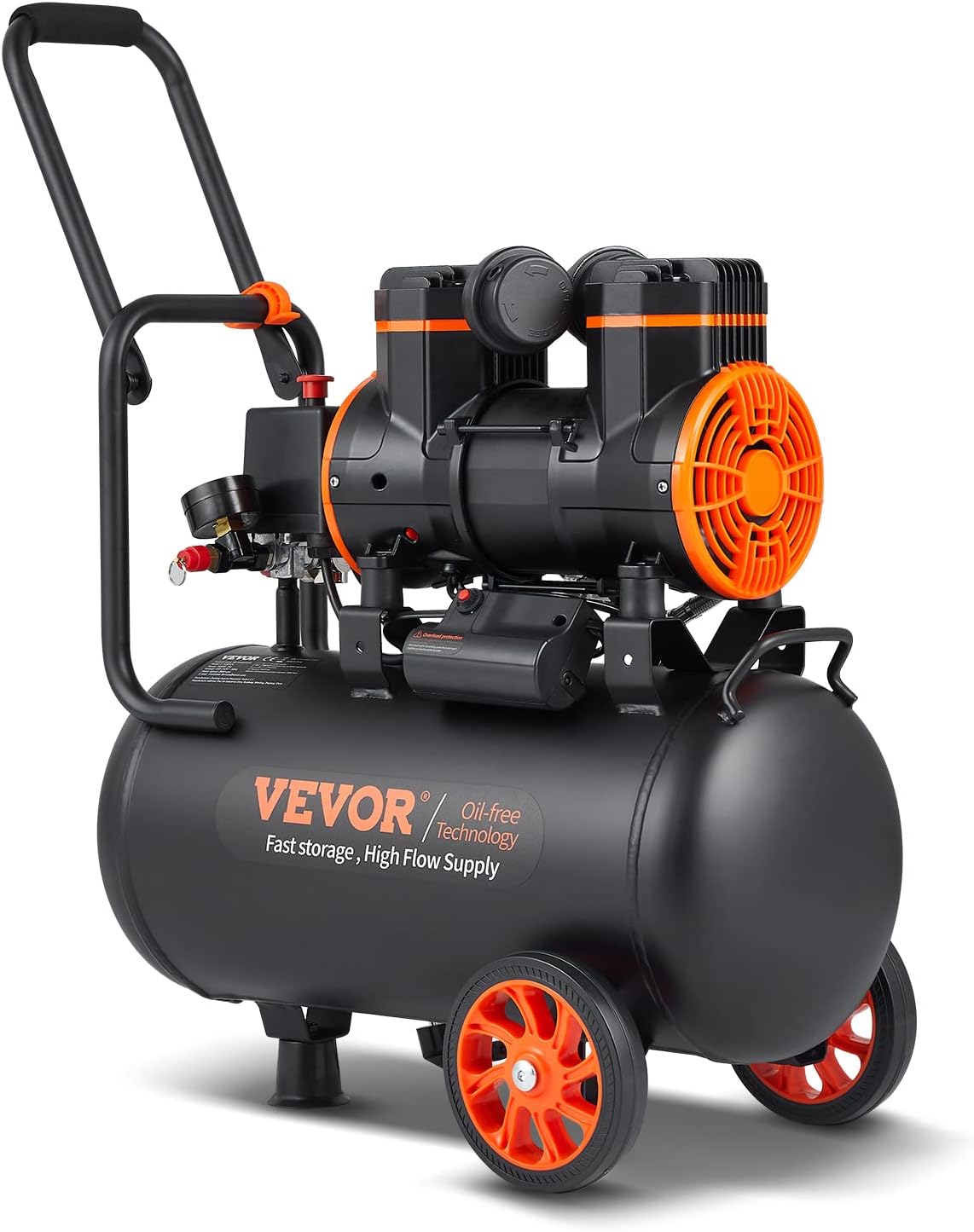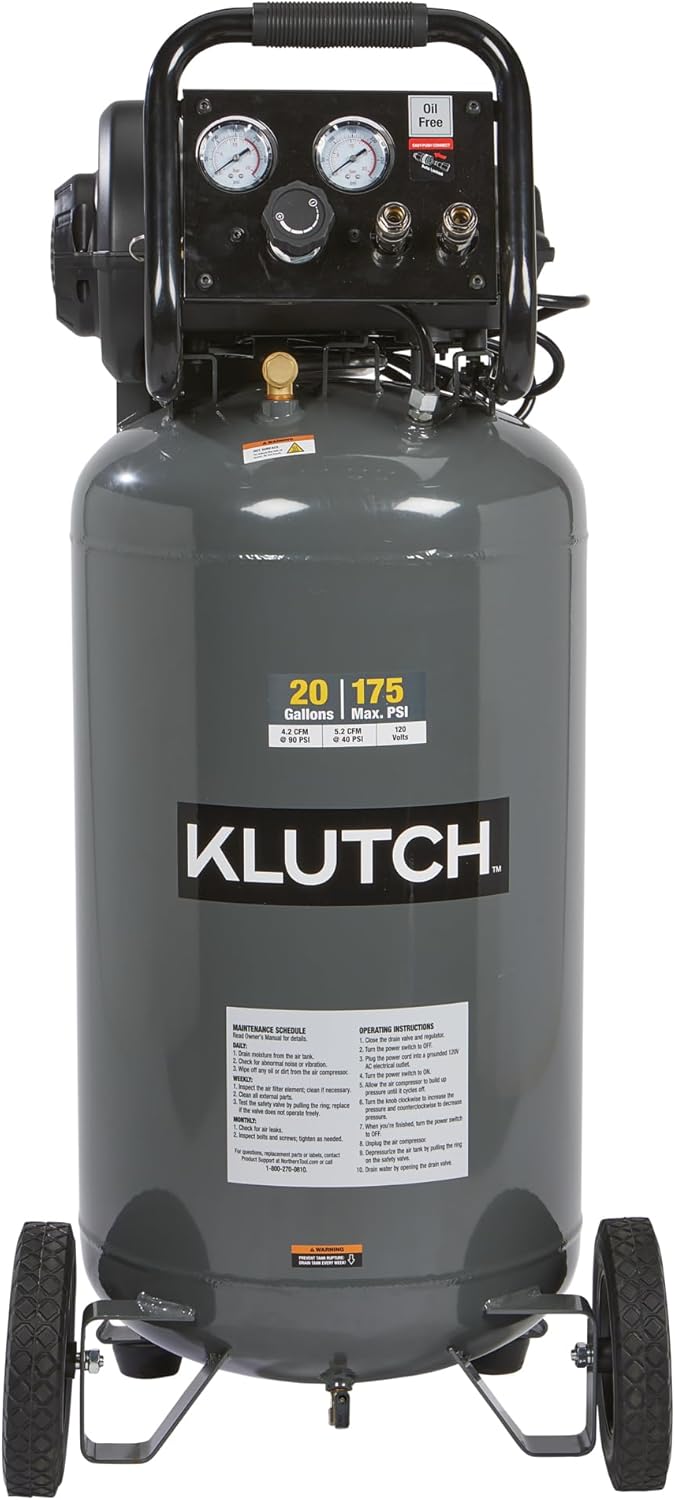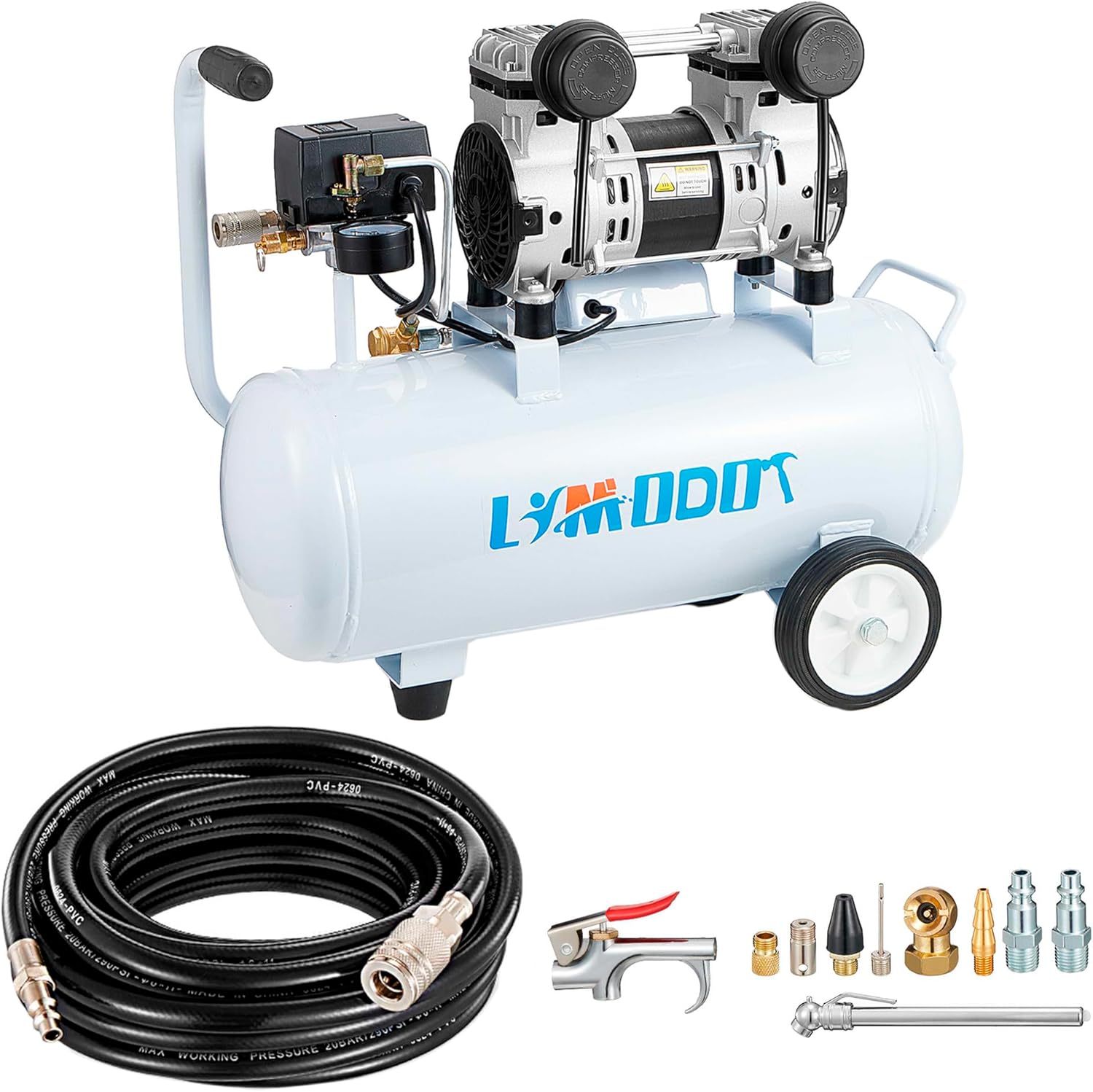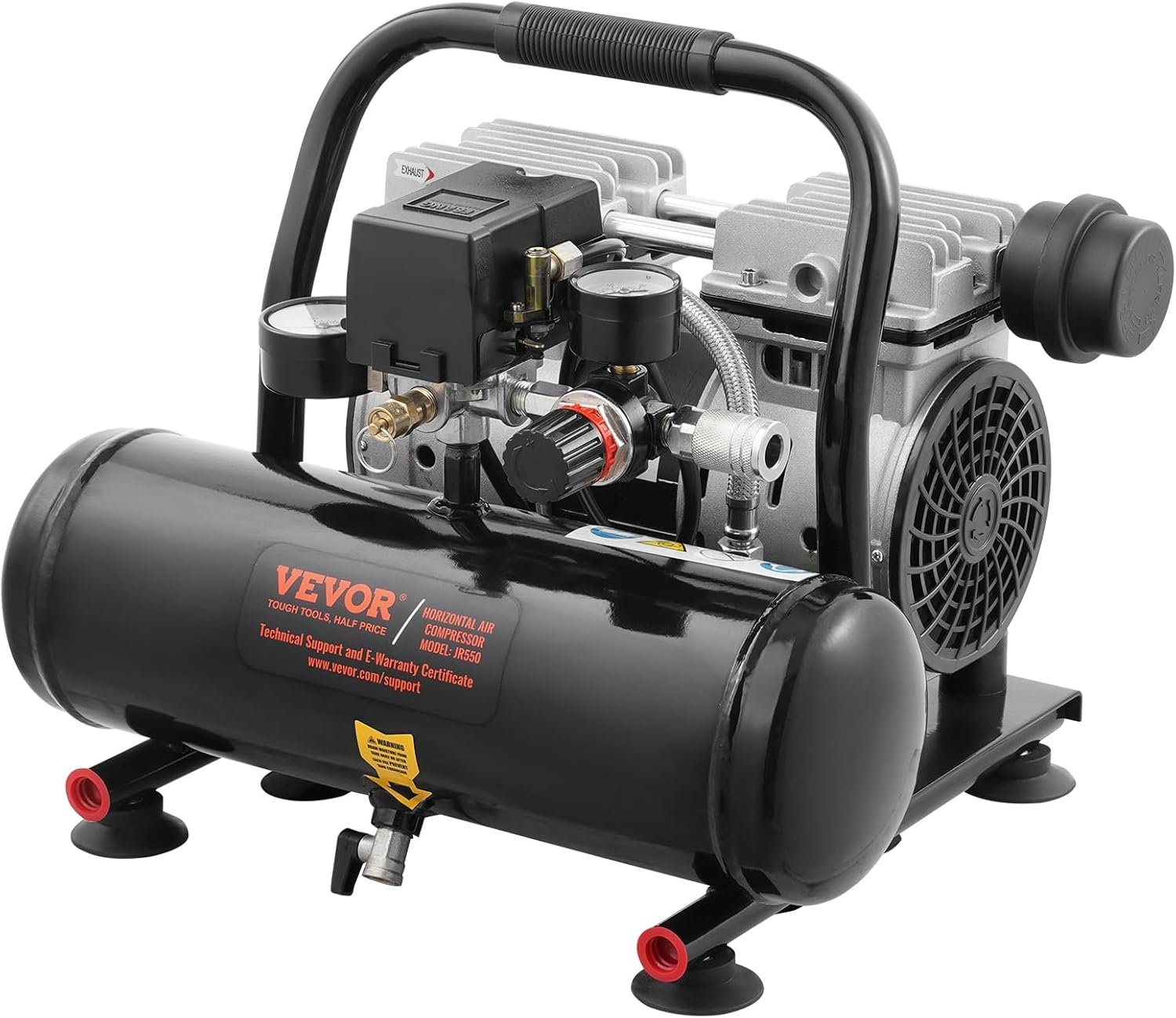Here’s an overview of the Best Air Compressor that we’ll explore today:
Top Pick
Portable Air Compressor |
||
Best Quality
VEVOR 6.3 Gallon Air Compressor |
||
Klutch 20-Gallon Air Compressor |
||
Quiet Air Compressor |
||
VEVOR Air Compressor |
Airbrushing and automotive spray painting demand a compressor that can deliver stable CFM at the required PSI, with quiet operation, reliable duty cycle, and rugged build. The five units in this guide span compact portable models to mid-size shop-capable units, all within a price range of $95.99 to $144.99. My evaluation focused on: (1) CFM at 90 PSI and 40 PSI to gauge spray consistency, (2) maximum operating pressure, (3) noise levels and heat management for long sessions, (4) tank size and duty cycle practicality for painting tasks, and (5) overall build quality, maintenance needs, and ease of use for home garages and small shops. The products covered include Baotree (Product 0), VEVOR 6.3 gallon (Product 2), Klutch (Product 3), Limodot (Product 4), and VEVOR 1 gallon (Product 5), representing a broad spectrum of capabilities within the budget-to-midrange segment.
1. Portable Air Compressor
- Brand: Baotree
- Manufacturer: Baotree
Overview: Baotree’s 4-gallon unit sits at the budget end of this cohort, delivering 110 PSI max with an oil-free pump and a modest 0.5HP motor. The rated 0.6 CFM @ 90 PSI and 1.0 CFM @ 40 PSI positions it as a practical mini-tan for light spray work, nailers, and tire inflation. It emphasizes portability and safety features like overpressure protection, and its 4G tank size provides a balanced reserve for small, intermittent painting tasks without excessive bulk. Prospective buyers get a compact, relatively quiet option with sufficient raw output for small projects. Cons include limited continuous spray capacity at higher PSI and a slower recovery profile compared to larger units, which may impede longer sessions or larger spray jobs.
Performance-wise, the Baotree 4G’s 0.5HP motor translates to lower operating noise and energy use, but the trade-off is duty cycle and sustained air delivery. For painting, you’ll want to prime small panels or touch-ups rather than full car panels. The unit’s 110 PSI max is adequate for small spray guns at moderate fan widths, but long, high-CFM spray sessions will cause pressure droop if the nozzle is demanding. The included safety features and a straightforward gauge layout help beginners monitor pressure easily, though users should account for regular maintenance and cleaning to prevent performance drift in dusty shop environments.
Pros
- Compact 4-gallon tank offers portability and quick setup
- Oil-free pump reduces maintenance and oil contamination risk
- Overpressure protection enhances operator safety
- Relatively quiet operation for its class
- Affordable entry point for light spray tasks
Cons
- Only 0.5HP limits sustained high-PSI spray performance
- CFM at 90 PSI is modest (0.6 CFM) for larger or continuous spraying
- Requires regular maintenance to maintain performance
2. VEVOR 6.3 Gallon Air Compressor
- Brand: VEVOR
- Manufacturer: VEVOR
Overview: The VEVOR 6.3G model positions itself as a robust midrange unit with a 2 HP oil-free pump and a 6.3 gallon tank, delivering 3.35 CFM at 90 PSI and a maximum 116 PSI. It targets versatile use—auto repair, tire inflation, spray painting, and light woodwork—while emphasizing durability with a rust/wear-resistant shell and dual cooling fans. It also incorporates noise-damping features (two silencers) to reduce acoustic signatures in a typical home shop setting. Prospective buyers benefit from a higher airflow reserve than smaller portable units without stepping into heavy industrial gear. Cons include a heavier footprint and higher initial cost relative to smaller compressors, and the 116 PSI max is not always essential for all spray applications.
In practice, the 3.35 CFM @ 90 PSI capability gives you a comfortable buffer for HVLP spray guns, nailers, and impact wrenches in short sessions. The dual-cylinder intake and robust build support faster recovery and steadier pressure under load, a meaningful advantage during longer painting passes or when balancing multiple tools. Noise remains a consideration at around 70 dB, but the included silencers and muffler design help keep it tolerable in a residential garage. The unit’s heavy build (approx. 43 pounds) benefits stability but reduces portability relative to the 4G Baotree.
Pros
- Higher CFM at 90 PSI (3.35 CFM) supports spray and tools more comfortably
- 2 HP oil-free motor provides solid performance with low maintenance
- Dual cooling fans and overheating protection enhance reliability
- Lower noise design (70 dB) with dual silencers
- Sturdy construction with rust/wear-resistant layers
Cons
- Heavier and less portable than smaller models
- Higher price within this comparison range
- Oil-free design, while low-maintenance, may still need care for long sessions
3. Klutch 20-Gallon Air Compressor
- Brand: Klutch
- Manufacturer: Klutch
Overview: Klutch’s 20-gallon, 2 HP shop-style compressor offers substantial tank capacity and a higher maximum pressure (175 PSI), with a 4.2 SCFM @ 90 PSI recovery rate. This positions it as a more capable option for longer spray runs and multiple tools in a garage setting, and its oil-free pump minimizes ongoing maintenance. The large tank diameter and mobility features (wheels and handle) facilitate placement in a shop while maintaining versatility for various tasks. Prospective buyers gain the ability to sustain spray sessions with less downtime, but the unit’s weight and footprint demand more space.
Performance-wise, the Klutch unit’s 4.2 SCFM @ 90 PSI translates to meaningful spray consistency over continuous runs, which is advantageous for larger panels or painting multiple components in one session. The 175 PSI max opens the door for higher-demand tools, though many automotive spray guns operate effectively well below that ceiling. Noise sits around 80 dB, which is typical for a shop-oriented compressor and may require sound-dampening considerations in tighter spaces. The rugged construction and dedicated oil-free pump reduce maintenance needs, while the 90-pound weight means planning for placement and occasional repositioning.
Pros
- Large 20-gallon tank enables longer, uninterrupted spray sessions
- 2 HP motor with high recovery (4.2 SCFM @ 90 PSI)
- High maximum pressure (175 PSI) supports diverse tools
- Oil-free pump reduces ongoing maintenance
- Portable for a shop environment with wheels and handle
Cons
- Heavy footprint (~90 pounds) lowers portability
- Higher noise level (80 dB) compared with smaller models
- Higher price and space requirements may deter casual users
4. Quiet Air Compressor
- Brand: Limodot
- Manufacturer: Limodot
Overview: Limodot’s 5-gallon steel-tank unit emphasizes ultra-quiet operation (68 dB) with a 1.2 HP induction motor and 2.8 CFM @ 90 PSI. It ships with a 13-piece accessory kit and a 25 ft hose, presenting a turnkey option for hobbyists and small shops focused on finishing work, brad nails, and light spray tasks. The combination of a quiet profile and included accessories makes it appealing for indoor use where noise is a concern. Prospective buyers should note that its 5-gallon tank yields less air reserve than larger shop compressors, which can impact longer sessions.
Performance-wise, the 1.2 HP motor provides a good balance of quiet operation and adequate airflow for finishing guns and light spray tasks. The 2.8 CFM @ 90 PSI figure is sufficient for smaller spray passes and nail guns, especially when working in a residential setting where noise control is valued. The kit’s 25 ft hose and 11 accessories elevate its immediate usability, but the smaller tank means shorter duty cycles if spraying larger panels, requiring more frequent replenishment.
Pros
- Ultra-quiet operation at 68 dB
- Includes a comprehensive accessories kit and hose
- Lightweight for a 5-gallon unit with good maneuverability
- Induction motor offers smooth, reliable starts
Cons
- Smaller 5-gallon tank limits spray duration
- Lower airflow at 90 PSI (2.8 CFM) compared to larger units
- Not ideal for high-volume painting tasks
5. VEVOR Air Compressor
- Brand: VEVOR
- Manufacturer: VEVOR
Overview: The VEVOR 1G model is the smallest unit in this comparison, delivering 1.5 CFM @ 90 PSI with a 1 HP pump and a max of 120 PSI. It is marketed as an ultra-quiet option (78 dB) with a 1-gallon tank and a compact footprint, making it well-suited for touch-ups, light inflations, and small spray tasks where space is at a premium. It’s a good match for enthusiasts who want a quick, quiet, low-cost solution for small projects or mobile use.
In use, the 1G VEVOR excels for patching, touch-ups, and delicate projects where you don’t need extended spray runs. However, the tank is small, so you’ll face frequent restarts and a quicker loss of pressure under even modest spray loads. The 1 HP motor provides decent responsiveness for light tools, and the 120 PSI ceiling supports many spray guns, but availability of air is the limiting factor for larger panels or continuous sessions. The included design focuses on portability rather than sustained shop-grade performance.
Pros
- Compact, highly portable
- Low noise for a small unit (78 dB)
- Reasonable 1.5 CFM @ 90 PSI for its size
- Affordable entry point for subtle tasks
- Good for mobile use and tight spaces
Cons
- Very small 1-gallon tank limits duty cycle
- Frequent restarts required for larger spray tasks
- Low overall airflow compared to midrange units
Frequently Asked Questions
We’ve compiled answers to the most common questions about air compressors to help you make an informed decision.
Conclusion
Final thoughts: For painting cars, the VEVOR 6.3G stands out as the best balance of size, airflow, and noise within the tested set, making it a versatile choice for hobbyists and small shops.
If ultimate spray endurance is needed, the Klutch 20G delivers longer runtimes at the cost of portability and price. Limodot’s 5G is the quietest option with solid accessory value, ideal for indoor use.
The Baotree 4G and VEVOR 1G are best reserved for light-duty tasks, portability, and budget-conscious purchases. Your choice should hinge on panel size, spray gun requirements, and how much noise you’re willing to tolerate in your workspace..
